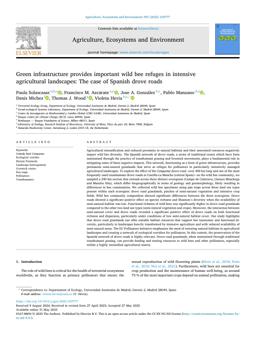2025-05-31
Green infrastructure provides important wild bee refuges in intensive agricultural landscapes: The case of Spanish drove roads
Publication
Publication
Agriculture, Ecosystems & Environment , Volume 393 - Issue 109777
Agricultural intensification and reduced proximity to natural habitats and their associated resources negatively impact wild bee diversity. The Spanish network of drove roads, a series of traditional routes which have been maintained through the practice of transhumant grazing and livestock movements, plays a fundamental role in mitigating some of these negative impacts. This network, functioning as a form of green infrastructure, provides permanent semi-natural grasslands that serve as refuges for pollinators in particularly intensively managed agricultural landscapes. To explore the effect of the Conquense drove road –over 400 km long and one of the most frequently used transhumant drove roads in Castilla-La Mancha (central Spain)– on the wild bee community, we sampled a 240 km section that extends across three distinct ecoregions (Campo de Calatrava, Llanura Manchega and Mancha Alta), which differ biogeographically in terms of geology and geomorphology, likely resulting in differences in bee communities. We collected wild bee specimens using pan traps across three land use types present within each ecoregion: drove road grasslands, patches of semi-natural vegetation and intensive crop fields. Wild bee community composition showed significant differences between the three ecoregions. Drove roads showed a significant positive effect on species richness and Shannon’s diversity when the availability of semi-natural habitat was low. Functional richness of wild bees was significantly higher in drove road grasslands compared to the other two land use types (semi-natural vegetation and crops). Moreover, the interaction between semi-natural cover and drove roads revealed a significant positive effect of drove roads on both functional richness and dispersion, particularly under conditions of low semi-natural habitat cover. Our study highlights that drove road grasslands can offer suitable habitat resources that support bee taxonomic and functional diversity, particularly in landscapes heavily transformed by intensive agriculture and with reduced availability of semi-natural areas. The EU Pollinators Initiative emphasizes the need of restoring natural habitats in agricultural landscapes and creating a network of ecological corridors for pollinators. In this context, the preservation of the Spanish network of drove roads is highly relevant. Drove road grasslands, when maintained through traditional transhumant grazing, can provide feeding and nesting resources to wild bees and other pollinators, especially within a highly intensified agricultural matrix.
| Additional Metadata | |
|---|---|
| , , , , , , , | |
| doi.org/10.1016/j.agee.2025.109777 | |
| Agriculture, Ecosystems & Environment | |
| Released under the CC-BY 4.0 (“Attribution 4.0 International”) License | |
| Organisation | Staff publications |
|
Solascasas, Paula, Azcárate, Francisco M., González, Jose A., Manzano, Pablo, Michez, Denis, Wood, T., & Hevia, Violeta. (2025). Green infrastructure provides important wild bee refuges in intensive agricultural landscapes: The case of Spanish drove roads. Agriculture, Ecosystems & Environment, 393(109777). doi:10.1016/j.agee.2025.109777 |
|
